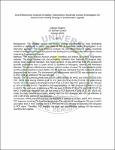| dc.contributor.author | Odongo, Dickens | |
| dc.contributor.author | Omech, Bernard | |
| dc.contributor.author | Acanga, Alfred | |
| dc.date.accessioned | 2023-03-30T10:14:06Z | |
| dc.date.available | 2023-03-30T10:14:06Z | |
| dc.date.issued | 2022 | |
| dc.identifier.citation | Odongo, D. , Omech, B. , and Acanga, A. (2022). Cost-Effectiveness Analysis of Adding Tuberculosis Household Contact Investigation On Passive Case Finding Strategy in Southwestern Uganda | en_US |
| dc.identifier.uri | http://ir.lirauni.ac.ug/xmlui/handle/123456789/534 | |
| dc.description.abstract | Background: The standard passive case-finding strategy implemented by most developing countries is inadequate to detect new cases of TB. A household contact investigation is an alternative approach. The study aimed to evaluate the cost-effectiveness of adding household contact investigation (HHCI) to the passive case-finding (PCF) strategy in the Tuberculosis control program in Southwestern Uganda.
Methods: The study utilized decision-analytic modeling and bottom-up costing (ingredients) methods. The study obtained cost and probability estimates from National TB program data, activity costs, published literature, and expert opinions. It was performed from the societal and provider perspectives over 1.5 years across 12 facilities in Ntungamo, Sheema, and Rwampara Districts. The primary effectiveness measure was the number of actual TB cases detected (yield) and the number needed to screen (NNS). The TB yield was calculated from the number of patients diagnosed over the screen. The incremental cost-effectiveness ratio (ICER) was expressed as cost in 2021 US$ per additional TB case detected.
Results: The TB screening yields were 0.52% (1496/289140) for HHCI and 5.8% (197/3414) for PCF. HHCI yield among children 0-14 Vs. 15+ years [6.2% Vs.5.4%] P=0.04. The yield among PLHIV Vs. HIV-negative [15.8% Vs.5.3%] P=0.03 in HHCI. The PCF yield in men Vs. Women [1.12% Vs.0.28%] P<0.01. The NNS in PCF was 193 [95% CI: 186–294] and 17 [95% CI: 14-22] in HHCI. The unit costs of detecting a TB case were US$ 204.22 for PCF and US$ 315.07 for HHCI. Patient and caregiver costs are five times in PCF than HHCI [US$ 26.37 Vs. US$ 5.42]. Under the study baseline assumption, adding HHCI to PCF strategies was not cost-effective at US$ 3,596.94 per additional case detected.
Conclusion: HHCI improves access to TB diagnosis in children 0-14 years and PLHIV; however, PCF improves access to TB diagnosis among men. The unit cost of detecting one TB case in HHCI was higher than in PCF. Adding HHCI to PCF was not cost-effective for detecting TB compared to PCF alone. Therefore, PCF remains the ideal and cost-effective strategy for low-resource countries like Uganda. | en_US |
| dc.language.iso | en | en_US |
| dc.publisher | Lira University | en_US |
| dc.subject | Cost-Effectiveness Analysis | en_US |
| dc.subject | Tuberculosis Household Contact | en_US |
| dc.subject | Southwestern Uganda | en_US |
| dc.title | Cost-Effectiveness Analysis of Adding Tuberculosis Household Contact Investigation On Passive Case Finding Strategy in Southwestern Uganda | en_US |
| dc.type | Thesis | en_US |

